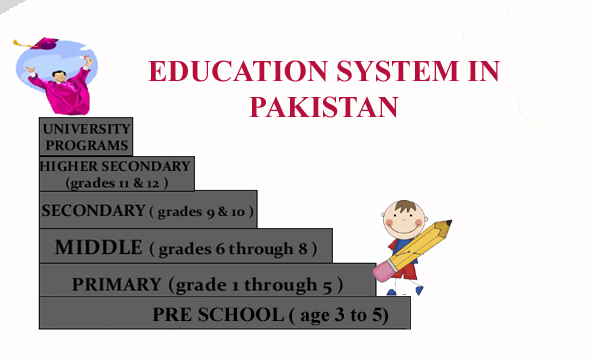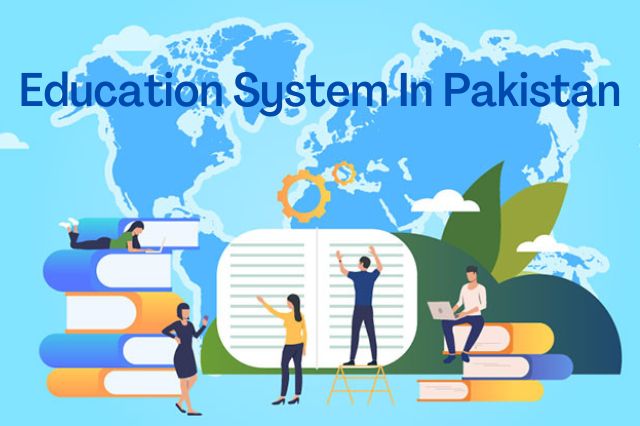The Education system in Pakistan is one of the world’s oldest. They brag about having one of Asia’s most comprehensive and effective courses.
Education System In Pakistan
The only way to achieve success is via education. There is education behind every successful man. Education has the power to transform a country from poverty to wealth. Education is both the most difficult and the most important task in human life.
The education system in Pakistan is extensive. It is made up of several elements that must be positioned appropriately. The government has an essential role in the country’s educational system. The government is in charge of developing policies to improve the education system in Pakistan.
The Federal Ministry of Education and the province governments control education system in Pakistan, with the federal government assisting with curriculum advancement, accreditation, and research and development financing. Under Article 25-A of the Pakistani Constitution, the state is obligated to offer free and obligatory quality education to children aged 5 to 16. “All children aged five to sixteen years old are entitled to free and compulsory education under the law.”
The education system in Pakistan is divided into six(6) levels

Preschool _(for ages from 3 to 5years).
Primary _(grades one through five).
High _(grade nine and ten, leading to SSC).
Intermediate _(grades eleven and twelve leading to HSSC).
University program _(leading to undergraduate & graduate degrees).
The Higher Education Commission is responsible for all universities and degree awarding institutes . Prof. Atta-ur-Rahman FRS, the Founding Chairman, established it in 2002.
Stages of formal education:
Primary Education:
Only around 67.5 percent of Pakistani children complete primary school. The standard national educational system is heavily influenced by the English educational system. Play Group, Nursery, and Kindergarten (sometimes known as ‘KG’ or ‘Prep’) are the three levels of pre-school education for children aged 3 to 5. Students attend junior high school from grades one to five after completing pre-school. Middle school, which runs from grades 6 to 8, follows. Society prefers single-sex education in middle school, however, co-education is also widespread in urban areas. The institution is usually in charge of the curriculum. The following are the eight most often studied disciplines:
_Arts
_Computer Science and Information Technology
_General Science(including Biology, Chemistry, and Physics)
_Urdu and English are two modern languages with literature.
_Mathematics
_Islamic Studies and Religious Education
_Social Sciences (including Civics, Economics, Sociology, Geography, and sometimes elements of law, politics & PHSE)
Secondary Education:
In Pakistan, secondary education starts in grade 9 and lasts four years. Students must pass a national examination administered by a regional Board of Intermediate & Secondary Education at the end of each school year.
After completing grade 9, students are required to take a standardized test in each of their academic subjects’ first portions (SSC-I). At the end of grade 10, they retake these assessments for the second part of the same subjects (SSC-II). They are awarded a Secondary School Certificate upon satisfactory completion of these exams (or SSC). This is known as a matriculation certificate, or simply ‘matric’. Generally, the curriculum consists of 8 courses.
In Pakistan O-Levels is considered equal to Matriculation and after completing O-Level, students can obtain admission Cambridge A- levels or On the other hand, they can also be admitted in FSc, ICS, I.Com or FA.
After that, students enroll in an intermediate college and finish grades 11 and 12. They take standardized tests in their academic subjects after finishing each of the two grades (HSSC-I and HSSC-II). Students are granted the Higher Secondary School Certificate after passing these examinations (or HSSC). This educational level is also known as FSc/FA/ICS or ‘intermediate.’ Pre-medical, pre-engineering, humanities (or social sciences), computer science, and business are just a few of the options available to students in grades 11 and 12.
Alternative qualifications are available in the education system in Pakistan but administered by different boards rather than the BISE.
Tertiary Education:
Students can pursue Bachelor’s degree programs in engineering (BE/BS/BSc Engineering), medicine (MBBS), dentistry (BDS), veterinary medicine (DVM), law (LLB), architecture (BArch), pharmacy (Pharm.D), and nursing after completing their HSSC (BSc Nursing). These courses take four or five years to complete. Pakistan Engineering Council (PEC), Pakistan Veterinary Medical Council (PVMC), Pakistan Medical Commission (PMC), Pakistan Bar Council (PBC), Town Planners (PCATP) and Pakistan Council for Architects, Pharmacy Council of Pakistan (PCP), and Pakistan Nursing Council are the accreditation councils that accredit the above professional degrees and register these professionals (PNC). Students can pursue Bachelor of Arts (BA), Bachelor of Science (BSc), Bachelor of Commerce (BCom), or Bachelor of Business Administration (BBA) degree programs at a university.
In Pakistan, there are two categories of bachelor’s degrees: pass and honors. Students usually read three optional topics (such as Chemistry or [Education] Economics) in addition to a nearly equal number of required subjects during their two years of study (such as English, Islamiat, and Pakistan Studies). Students who pursue an honors degree usually concentrate on a certain subject of study (BSc Hons. Biochemistry).
Quaternary Education:
Two years is the average length of a Master’s degree program. Most fields have a Master of Philosophy (MPhil) program that can be pursued after completing a master’s degree. Doctor of Philosophy (Ph.D.) degrees are available in a limited number of areas and are often pursued after receiving an MPhil. MPhil and Ph.D. students must choose a specific field and a university that does research on that topic. In Pakistan, MPhil and Ph.D. programs take at least 2 years to finish.
Nonformal And Informal Education:
Out of the formal system, the public sector operates various schools and training centers most of which are vocational in nature. Vocational schools, technical training centers, and agriculture and vocational training centers are among those institutions.
The public sector operates various schools and training centers outside of the formal system, most of which are vocational in nature. Vocational schools, technical training centers, and agriculture and vocational training centers are among those institutions. Pakistan has also established an apprenticeship program. In Pakistan, informal education is also important, and it consists primarily of school dropouts and low-skilled workers who are trained under the supervision of a senior craftsman. Few corporate-run institutes exist to prepare university students for jobs and provide experience during their education, bridging the gap between university and industry. For example, Appxone Private Limited trains engineers in major subjects such as electronics and computer science, among other fields.
Madrassas:
Islamic seminaries are known as madrassas. Most Madrasas teach largely Islamic subjects like Tafseer (Quran interpretation), Hadith (Muhammad’s sayings), Fiqh (Islamic Law), Arabic language, and certain non-Islamic courses like logic, philosophy, and mathematics to help students understand the religious ones. Madrassas are popular among Pakistan’s poorest families because they provide food and shelter for their students. The number of madrasas is estimated to be between 12,000 and 40,000.
Literacy Rate In 2023:
The literacy rate of Pakistan in 2023 is 59.13%.
In Islamabad, the literacy rate is 82 percent, while in Torghar, it is 23 percent. Literacy rates differ by gender and region. Female literacy is 9.5 percent in tribal areas, while Azad Kashmir has a literacy rate of 74 percent. Every year, Pakistan generates 445,000 university graduates and 25,000-30,000 computer science graduates. Despite these figures, Pakistan’s literacy rate remains low. After Nigeria, Pakistan has the second-largest out-of-school population (22.8 million children).
Also Check:
